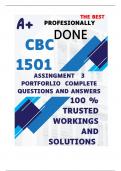,CBC1501 Assignment 3 PORTFOLIO (COMPLETE
ANSWERS) Semester 2 2024 - DUE 10 October
2024; 100% TRUSTED Complete, trusted solutions
and explanations.
MAIN SCENARIO Read the following scenario before answering
questions 2–4: Dr Shadi Hashimi has been appointed as a senior
researcher in the Department of Communication Science at the
University of South Africa (Unisa). His research focuses on
ethical communications in the era of the fifth industrial
revolution (5IR). Some of his research interests delve into the
issues of the digital footprint, digital literacy, verbal and non-
verbal communication and virtual teams. Some of his
preliminary research findings have identified key areas of
concern regarding the readiness of the South African youth for
the 5IR. The concerns that he has listed appear below: 1. The
South African youth lack basic digital literacy skills 2. Although
many youth have access to digital devices, they use these
devices for entertainment purposes and not for educational
purposes. 3. Netiquette in many areas of virtual collaboration is
ignored. 4. There is poor intercultural, multicultural and cross-
cultural awareness when interacting in virtual teams. 5. The
youth do not understand the importance of effective verbal and
non-verbal communication when interacting with others in a
virtual space. Dr Shadi Hashimi is thus concerned about these
issues and wants to address these concerns with key
stakeholders in the country. He is finalising his research findings
to share on various platforms. Firstly, he aims to distribute his
,research findings through academic publications, public
participation forums, research reports, mass media and social
media platforms, as well as through oral presentations in
different contexts. To do this, he has to identify the target
audience, the goal and the purpose of his communication for
each type of communication he plans to disseminate. Page 8 of
15 4.
To address Dr. Shadi Hashimi's research findings effectively, it’s
essential to identify the target audience, goals, and purposes
for each communication method he plans to use. Below is a
structured approach to this dissemination strategy:
1. Academic Publications
Target Audience: Academics, researchers, and students in
the field of Communication Science and related disciplines.
Goal: To contribute to scholarly discourse on ethical
communication and the digital landscape, sharing
empirical findings that can influence future research.
Purpose: To provide a comprehensive analysis of the
research findings, peer-reviewed validation, and practical
implications for academia and policy development.
2. Public Participation Forums
Target Audience: Community members, educators,
parents, youth organizations, and policymakers.
, Goal: To engage the community in discussions about digital
literacy and ethical communication, fostering awareness
and collaboration.
Purpose: To facilitate dialogue, gather feedback, and
encourage community involvement in addressing the
issues identified in the research, promoting collective
action and solution development.
3. Research Reports
Target Audience: Government agencies, educational
institutions, NGOs, and stakeholders involved in youth
development and education.
Goal: To provide detailed insights and recommendations
based on the research findings, aimed at influencing policy
and educational practices.
Purpose: To inform stakeholders about the current state of
youth readiness for the 5IR and advocate for strategic
interventions that enhance digital literacy and
communication skills.
4. Mass Media
Target Audience: The general public, including youth,
parents, and educators.
Goal: To raise awareness about the issues facing South
African youth in the digital age.




